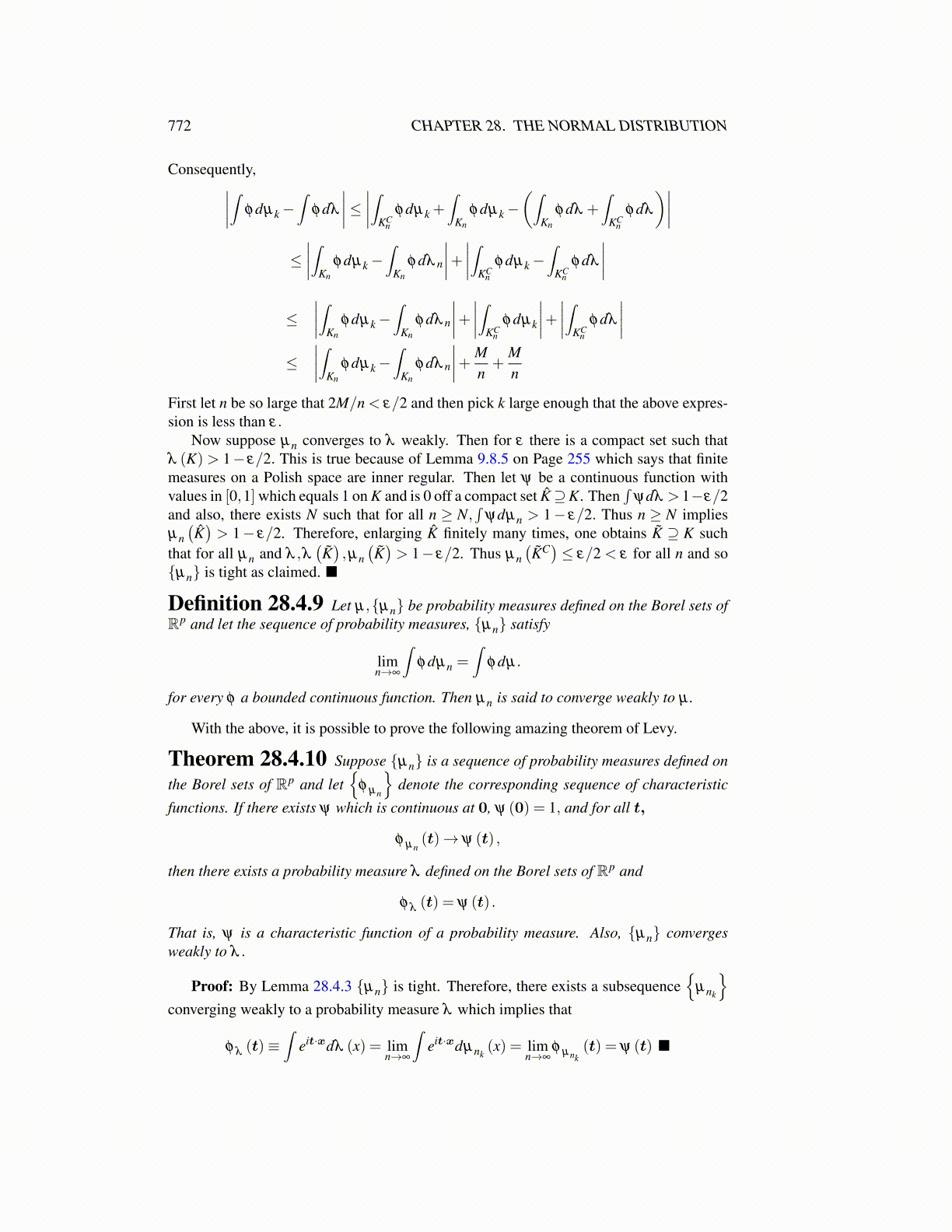
772 CHAPTER 28. THE NORMAL DISTRIBUTION
Consequently,∣∣∣∣∫ φdµk−∫
φdλ
∣∣∣∣≤ ∣∣∣∣∫KCn
φdµk +∫
Kn
φdµk−(∫
Kn
φdλ +∫
KCn
φdλ
)∣∣∣∣≤∣∣∣∣∫Kn
φdµk−∫
Kn
φdλ n
∣∣∣∣+ ∣∣∣∣∫KCn
φdµk−∫
KCn
φdλ
∣∣∣∣≤
∣∣∣∣∫Kn
φdµk−∫
Kn
φdλ n
∣∣∣∣+ ∣∣∣∣∫KCn
φdµk
∣∣∣∣+ ∣∣∣∣∫KCn
φdλ
∣∣∣∣≤
∣∣∣∣∫Kn
φdµk−∫
Kn
φdλ n
∣∣∣∣+ Mn+
Mn
First let n be so large that 2M/n < ε/2 and then pick k large enough that the above expres-sion is less than ε.
Now suppose µn converges to λ weakly. Then for ε there is a compact set such thatλ (K) > 1− ε/2. This is true because of Lemma 9.8.5 on Page 255 which says that finitemeasures on a Polish space are inner regular. Then let ψ be a continuous function withvalues in [0,1] which equals 1 on K and is 0 off a compact set K̂⊇K. Then
∫ψdλ > 1−ε/2
and also, there exists N such that for all n ≥ N,∫
ψdµn > 1− ε/2. Thus n ≥ N impliesµn(K̂)> 1− ε/2. Therefore, enlarging K̂ finitely many times, one obtains K̃ ⊇ K such
that for all µn and λ ,λ(K̃),µn
(K̃)> 1− ε/2. Thus µn
(K̃C)≤ ε/2 < ε for all n and so
{µn} is tight as claimed. ■
Definition 28.4.9 Let µ,{µn} be probability measures defined on the Borel sets ofRp and let the sequence of probability measures, {µn} satisfy
limn→∞
∫φdµn =
∫φdµ.
for every φ a bounded continuous function. Then µn is said to converge weakly to µ .
With the above, it is possible to prove the following amazing theorem of Levy.
Theorem 28.4.10 Suppose {µn} is a sequence of probability measures defined on
the Borel sets of Rp and let{
φ µn
}denote the corresponding sequence of characteristic
functions. If there exists ψ which is continuous at 0, ψ (0) = 1, and for all t,
φ µn(t)→ ψ (t) ,
then there exists a probability measure λ defined on the Borel sets of Rp and
φ λ (t) = ψ (t) .
That is, ψ is a characteristic function of a probability measure. Also, {µn} convergesweakly to λ .
Proof: By Lemma 28.4.3 {µn} is tight. Therefore, there exists a subsequence{
µnk
}converging weakly to a probability measure λ which implies that
φ λ (t)≡∫
eit·xdλ (x) = limn→∞
∫eit·xdµnk
(x) = limn→∞
φ µnk(t) = ψ (t) ■